Prison
Prison Documentation
Prison Documents - Table of Contents
Prison - Placeholder Guide
This document covers different aspects of placeholders within Prison. It explains how they work, how to use them, and different ways to use them.
Documented updated: 2023-09-21
Overview
Placeholders allow the sharing of data from one plugin with another plugin, and without either plugin knowing anything about each other.
On the surface they appear to be simple, but there are a lot of moving parts below the surface, and with Prison, there are even more complicated things going on.
Add in to the mix, that different plugins deal with placeholders in slightly different ways, and you can wind up with a challenge to get them to work under different circumstances.
New Feature! Custom Placeholders!
Prison now supports the creation of custom placeholders, which can include any text, with formatting, and any number of placeholders too. Even non-prison placeholders. The benefit of custom placeholders is that you can create complex placeholders in one place, within prison, at any length, and then use them in any of your other plugins such as holographic displays, scoreboards, etc… Prison will expand all placeholders, including from other plugins, and provide the final result.
Placeholder Commands
Since Prison v3.2.1-alpha.13
There are a few useful commands within prison that will allow you list placeholders, search for placeholders, and to test random text that includes placeholders.
Sub-command listing of all placeholders commands:
- /prison placeholders
Shows a list of all of the placeholder related commands.
- /prison placeholders list
Lists all placeholders that are available, including their aliases. Placeholders are grouped by their type, of which there are 10 different kinds. Some are player specific, rank or ladder specific, mine specific, or even hybrid combinations such as player-mine were the mine stats are based upon which mine the player is in.
- /prison placeholders search
Provides a simple search for placeholders, optionally using a player’s name, and it shows the results with actual live placeholder values. Search values can be one or more word fragments.
- /prison placeholders test
Somewhat like search, but you have to provide the whole placeholder surrounded by escape characcters. Can provide more than one placeholder too. This is more like testing what you would place within a chat prefix or holographic sign.
- /prison placeholders stats
A new command that currently only shows what placeholders have been hitting prison and their total hit count and the total average duration to process. This tool provides a simple pre-cache to more quickly identify which is the correct placeholder to use with the raw placeholder text. This even includes bad placeholder hits so the pre-cache can bypass processing of the junk, which improves server performance. Eventually this will also include a placeholder value cache.
The placeholder cache helps reduce the cost of resolving the correct placeholder.
To clear and reset the placeholder cache, use the command
/prison placeholders stats resetCache.
NOTE: Viewing and resetting the placeholder cache/stats is a good way to debug possible placeholder problems. This can confirm if prison is getting requests for the given placeholder, or if a placeholder that you’re using is bad or incorrect.
- /prison placeholders reload
Reloads and rebuilds all placeholders and then reregisters them. This is performed when adding or removing a new mine or rank.
NOTE: the /prison placeholders reload command only reloads and registers the placeholders with the placeholder integrations. This would be required to enable placeholders when adding a new mine, a new rank, or a new ladder. If you reload another plugin, such as papi, you may need to reload the placeholders which will re-register them. Prison has been setup to survive a papi restart, but there could still be issues.
NOTE: Information on these command are provided in detail below.
Placeholder Types and Counts
Prison has numerous placeholders, with number of different types. Each of these types have different internal requirements and conditions of usage. This is a high overview of the various types and their counts.
-
Total Available Placeholders: 294 including aliases
- Player Related: 112 including aliases
- Rank Related: 8 including aliases
- Rankup Related: 20 including aliases
- Player Balance Related: 8 including aliases
- Player Token Balance Related: 12 including aliases
- **Player Blocks Totals Related: 4 including aliases
- Player Tool Related: 34 including aliases
- Player Health Related: 14 including aliases
- Player XP and Levels Related: 6 including aliases
- Player Walk Speed: 2 including aliases
- Ladders Related: 34 including aliases times each ladder
A LADDERS placeholder must include the ladder’s name in the placeholder and therefore is static.
The ladder based placeholders end with
_laddername, but they include the following possible prefixes, which may not be exclusive to ladder based placeholders.
Ladder placeholder prefixes:
prison_rank_prison_rankup_prison_player_
- Ranks Related: 24 including aliases times each rank
A RANKS placeholder needs to specify the Rank name as part of the placeholder. Each placeholder must specify a Rank and is static.
The ranks based placeholders end with
_ranknamebut do not require a player to work. They also have a prefix ofprison_rank__but these prefixes and suffixes are also shared with RankPlayers placeholders. See them for specifics.
Ranks placeholder prefixes:
prison_rank__
- RankPlayers Related: 12 including aliases times each rank
A RANKPLAYERS placeholder is one that will change based upon the player’s own Rank. Each player could have a different rank. Because of this relationship, these can only be used with instances of players such as scoreboards and chat prefixes; they will not work in holographic displays or with signs.
RankPlayers placeholders are very similar to the Rank placeholders in respect to the prefixes and suffixes, but these placeholders MUST include a player or they cannot work. Without a player, they cannot return a valid value, and therefore will return either a blank or zero.
What makes these placeholders stand out from rank placeholders is the prefix includes
player_. For example:
RankPlayers placeholder prefixes:
prison_rank__player_
Performance Warning: There is a high risk of performance issues when calculating a full GUI page of items that includes the use of placeholders that are based upon the placeholders:
prison_rank__player_cost_rankname. The reason for this is related to a progressively great number of calculations required to calculate high ranked prestige ranks. The performance impact can include processing and memory usages.
For example, if there are 26 default ranks, and the player is at rank A with no prestiges, then to calculate rank P4 would include the following ranks: b –> z + p1 + a –> z + p2 + a –> z + p3 + a –> z + p4.
This results in a total of 107 ranks that must be collected, then the player’s cost for each rank will have to be calculated. Then all of these must be added together to get the player’s cost on rank P4.
So if there are thousands of prestige ranks, then the calculations will be numerous for each placeholder.
-
Player Ladder Balance Related: 32 including aliases times each Mine
-
Mines Related: 28 including aliases times each ladder
A MINES placeholder must specify the Mine mine as part of the placeholder.
The Mines related placeholders have the following prefixes, but they are also shared with the MinePlayers placeholders.
prison_mines_prison_top_mine_
- MinePlayers Related: 32 including aliases
A MINEPLAYERS placholder is similar to a RankPlayers placeholder in that it is dynamic and you cannot specify a mine’s name with it. How it works, is that it provides the related stats for the mine in which the player is standing in. When the player leaves the mine, then these placeholders returns an empty string value (a blank).
The MinePLayers placeholders includ the following prefixes, but they are also similar to the Mines related placeholder too:
prison_player_prison_mines_
- PLAYERBLOCKS: 4 including aliases
Every block type that a player breaks within a mine is tracked. These provide the stats on those blocks.
- STATSMINES Related: 18 including aliases
These list the blocks within a mine. They are referred to with a
_nnn_notation where “nnn” is the line number
- STATSRANKS Related: 6 including aliases
Top-n stats for each rank. The rank name must be specified on the placeholder.
- STATSPLAYERS: 30 including aliases
Various placeholders for the top-n ranked players. These are over all ranks. There are a couple of shortcut placehodlders where one placeholders contain multiple fileds for easier usage.
- ONLY_DEFAULT_OR_PRESTIGES: 4 including aliases
A couple of placeholders that will only include the default and prestige ladder’s rank tag name. These are handy such that you only need to use the one, and it will ensure none of the other ladder’s ranks will be included.
- CUSTOM: Depends upon how many are configured on your server.
Custom placeholders allow for the creation of complex text that can include many other placeholders, including their placeholder attributes and other plugin placeholders. The benefit is that when using these in another plugin, you just need to use the short simple placeholder name and it will auto expand everything for you.
Requirements
There is always more than one way to do things, and the same goes for having more than one way to use placeholders. This documentation, and our test servers, primarily rely on the use of PlaceholderAPI as the core component to making placeholders work. Depending upon other plugins that you may use, they may have other dependencies too.
PlaceholderAPI - Setting up PlaceholderAPI - Strongly Suggested if using placeholders.
Holographs and Scoreboards - There are actual a couple of holograph display plugins. Most of the references in this document refer to Holographic Displays, but some of the newer plugins can provide the same functionality, plus many new features.
Some of example of other holographic plugins are: AnimatedScoreboard, DecentHolograms, Scoreboard Revision, and etc..
Placeholder Theory for Prison
(needs updating: Prison now has 10 types of placeholders including top-n variations)
There are few major types of placeholders in prison: Player, Ranks, Ladders, Mines, and Stats based. With the most recent releases of prison, there have been hybrids added that are a combination of the player placeholders and with mines and ranks. For example there are now ladder based placeholder that allow targeting ranks on a specific ladder, instead of all ladders. Also there are player mine placeholders that report on the mine stats for the mine in which the player is physically located in. The player mine placeholders have no value when the player is not in a mine, and they will change as the player goes from mine to mine.
There are also different types of data that are returned in placeholders. Text, numbers, formatted numbers, and bar graphs.
The player based placeholders can only report on the player that is initiating the command, or request. These placeholders pertain to the player’s attributes, such as rank, next rank, their balance, how more they need before reaching the next rank, and etc. Internally, all of these requests must include the player’s UUID, which is why you cannot just add them to a sign, since the sign does not know any player’s UUID.
There are actually two major kinds of player based placeholders; a third type is “related” more to mines and not specifically to the player’s ranks. Rank placeholders that returns all of the player’s current attributes for all active ladders they are associated with. For example, if they are active on four ladders, then they will have four active ranks on four ladders with possible values. So it may look something like this: [mod][Zeus][+2][B], of which the ladders could be mod, donor, prestige, and default. The thing to remember about player rank placeholders is that they may return more than one value, and you cannot control the order of the values.
The other player based placeholders, which complements the Rank Placeholders, are the ladder placeholders that narrows the ranks down to a specific ladder. So with our example above, if you only want the ranks from the default ladder, that is now possible. Also you can control the order they appear by ordering the ladder placeholders in a specific sequence.
NOTE: Player based placeholders can now be used with non-player placeholders by using a placeholder attribute’s player=<playerName> attribute.
The Mine based placeholders provide details about mines, and the mine name becomes part of the placeholder name. Out of all of the possible mine based placeholders, each one is duplicated for each mine. So, in rough terms, if there are different mine placeholders and you have 40 mines, then prison will generate about 400 place holders: 40 mines x 10 placeholders each = 400 placeholders for prison.
The same applies to the ladder placeholders as the mine placeholders; for every ladder, there will be a specific placeholder that represents each ladder.
Prison has integrations for direct use of providing placeholder values to to the other plugins. Some of those other plugins request placeholder values using partial placeholder names. Therefore to improve performance and to prevent having to always reconstructing the full placeholder names, prison precomputes the fragments for all placeholders. Therefore, with our example of 40 mines and 10 placeholders, the actual internal number of placeholder combinations that prison will respond to is 800: 40 mines x 10 placeholders per mine x 2 for aliases = 800 placeholders for prison.
Off hand this may sound bad, but Prison utilizes enumerations for identifying placeholders, so they may be objects, but they are lightweight and helps ensure placeholders align with the code at compile time. This not only provides better performance, and less memory consumption, but programming errors and typos are caught at compile time and not runtime, so they also provide for a more stable and reliable Prison environment.
Internally, placeholders within Prison are case insensitive. But Prison uses lower cased placeholder names to register with any placeholder integration. Therefore, although prison may be case insensitive, the placeholder plugins may not recognize the placeholders unless you use them as all lower case names.
Also, internally, prison only responds to the placeholder name without the escape characters. The escape characters are generally curly braces { }, or percents % %, but may be other characters. All placeholder plugins strip off the escape characters before passing anything to prison. So proper use of placeholders is dependent upon what is being required by your placeholder plugin and may require a mix of escape characters.
Placeholder Attributes - Customize almost any Prison Placeholder
Since Prison v3.2.4-alpha.2
Placeholders within prison can now be dynamically customized without having to make any changes to any configurations. The same placeholder can be used in multiple place, each with different configurations. This is now possible through the use of placeholder attributes and offers a large degree of customization.
The Placeholder Attributes is additional text that is added at the end of a placeholder but within the escape characters. The placeholder attribute always begins with a double colon :: and each parameter is separated with a single colon :. Some placeholders cannot use the attributes, and not all attributes can be used on a placeholder. See additional information below that pertains to each attribute.
Player based placeholders require player based requests that includes the player. Plugins that provide player based context would be like chat prefixes, scoreboards, and other placeholder consumers that need to use the player based placeholders. Some examples of placeholder consumers that will not have player based contexts, are with scoreboards and some script environments; these requests for player based placeholders would normally fail under regular conditions. To use player based placeholders with plugins that cannot support the player, you can solve this issue with the use of placeholder attributes with the player=<playerName> attribute. See notes below on all placeholder attribute types.
As of v3.3.0-alpha.11h one placeholder can have more than one Placeholder Attribute, but they have to be of a different type. At this time, this really is not beneficial since the Placeholder Attributes are specific to a certain type of data. But this opens the door to future possibilities that are not possible currently, such as hybrid between a bar graph with a value super-imposed on top of it.
The following shows how a few placeholder need to have the “minename” replaced with the actual mine’s name. For these examples, we will use a mine named temp5.
- prison_mines_size_minename -
{prison_mines_size_temp5} - prison_mines_remaining_minename -
{prison_mines_remaining_temp5} - prison_mines_remaining_bar_minename -
{prison_mines_remaining_bar_temp5} - prison_mines_timeleft_bar_minename -
{prison_mines_timeleft_bar_temp5}
A few Examples using Placeholder Attributes:
{prison_mines_size_temp5::nFormat:#,##0}- 654,321{prison_mines_size_temp5::nFormat:#,##0:0:none}- 654,321{prison_mines_size_temp5::nFormat:#,##0.00:1:kmg}- 654.32 k-
{prison_mines_size_temp5::nFormat:#,##0:0:kmg}- 654k {prison_mines_remaining_bar_temp5}- Normally displays as (no color)- »»»»»»»»»»»»»»»»»«««
{prison_mines_remaining_bar_temp5::bar:10}- Using default values, but change length to 10- »»»»><
{prison_mines_remaining_bar_temp5::bar:10:&2:#:&d:-}- Change all settings- #######—
{prison_mines_timeleft_bar_temp5::bar:40:&2:O:&d:x:debug}- Enable debug mode for the attribute- OOOOOOOOOOOOOOOOOOOOOOOOOOOOOOOOxxxxxxxx
-
{prison_rank_tag::text:player=RoyalBlueRanger}- When used in non-player supported plugins, such as holographic displays, this will enable the use of player-based placeholders for the specified player. {prison_rankup_cost_remaining_formatted::nFormat:player=RoyalBlueRanger}- When used in non-player supported plugins, such as holographic displays, this will enable the use of player-based placeholders for the specified player.
The examples above don’t show the color for the bar graphs, but here is a screen print that uses a prison command to test the placeholders dynamically within prison:
The placeholder: {prison_mines_timeleft_bar_temp5::bar:40:&2:O:&d:x:debug}
The full command:
/prison placeholders test {prison_mines_timeleft_bar_temp5::bar:40:&2:O:&d:x:debug}

When debug mode is enabled, it will print to the console information about the placeholder attribute, as seen in the above screen print. This could be useful when testing the configuration of placeholder attributes
Using the command /prison placeholders test should be used to test and perfect the use of the placeholder attributes.
Placeholder Attribute: nFormat - Numeric Formats
The Numeric Format attribute will only work on placeholders that return plain numbers. If there is a “_format” version of the placeholder, then an attribute will override the default formatting.
Example of this attribute’s usage is as follows, using descriptions for each parameter.
::nFormat:format:spaces:unitType:hex:hex2:debug:player=<playerNamme>
- nFormat: the keyword to identify this attribute.</li>
- format: formatting based upon Java’s DecimalFormat class.
Required. Defaults to #,##0.00. Examples of
how the formatting can be used:
- #,###
- #,###.00
- #,###.00000
- spaces: number of spaces between format and unit of measure. Optional. Defaults to 1.
-
unitType: unit type to display or to use to transform the results. Optional. Defaults to the placeholder type that is used.
- none: No display of units. No transformations.
- kmg: Uses one character units: kMGTPEZY. Transforms results by
dividing by 1000.0 until value is less than 1000.0, and
each time it increments the unit character.
k=1,000, M=1,000,000 and etc. These are metric SI codes. - kmbt: Uses one character units: KMBTqQsS. Transforms results by
dividing by 1000.0 until value is less than 1000.0, and
each time it increments the unit character.
k=1,000, M=1,000,000 and etc. These are non-standard codes. -
binary: Uses a base-two divisor of 1024 along with the units: KB, MB, GB, TB, PB, EB, ZB, and YB.
- Note: Other unitTypes can be added along with different style of reducers. Contact support for these requests.
- hex: Optional. Case sensitive. Non-positional; can be placed anywhere. Only valid value is “hex”. When enabled it will translate hex color codes, and other color codes before sending the placeholder results back to the requestor. This is useful for plugins that do not directly support hex color codes.
- hex2: Optional. Case sensitive. Non-positional; can be placed anywhere. Only valid value is “hex2”. When enabled it will translate hex color codes to their intermediate state, which uses ‘&’ color codes, sending the placeholder results back to the requestor. This is useful for plugins that do not directly support hex color codes and may work when ‘hex’ does not.
-
debug: Optional. Case sensitive. Non-positional; can be placed anywhere. Only valid value is “debug”. When enabled it will log to the console the status of this attribute, along with any error messages that may occur when applying the attribute.
- player=<playerName>: Optional. Case insensitive. Non-positional; can be placed anywhere. If provided, it will try to use the specified player as the primary player for the placeholder. If the current user is provided, then this parameter may be ignored.
The parameters that are optional do not have to be included, unless another parameter after the optional ones are needed. Then the optional parameter must be supplied and cannot be empty.
{prison_mines_size_temp5::nFormat:#,##0.00:1:kmg}
Although it is not suggested to include color codes in the formatting of numbers, it may be possible with the addition of the quoting them with single quotes. The following use of hex2 format works well with testing on a scoreboard that does not support hex colors, and is a way to inject the hex color when it cannot be used directly in the scoreboard configs.
{prison_mines_size_temp5::nFormat:'#af33ff'#,##0.00:1:kmg:hex}
{prison_mines_size_temp5::nFormat:'#af33ff'#,##0.00:1:kmg:hex2}
Placeholder Attribute: bar - Bar Graphs
The bar placeholder attribute only works with placeholders with the word bar in them.
Example of this attribute’s usage is as follows, using descriptions for each parameter.
::bar:size:posColor:posSeg:negColor:negSeg:reverse:hex:hex2:debug:player=<playerNamme>
- bar: the keyword to identify this attribute.
- size: The number of segments to generate.
- Positive Color: The color code to use for the positive segments. Color codes should start with an &.
- Positive Segment: The value that will be used for the positive segment.
- Negative Color: The color code to use for the negative segments. Color codes should start with an &.
-
Negative Segment: The value that will be used for the negative segment.
-
reverse: Optional. Case sensitive. Non-positional; can be placed anywhere. When enabled, this will reverse the bar graph.
- hex: Optional. Case sensitive. Non-positional; can be placed anywhere. Only valid value is “hex”. When enabled it will translate hex color codes, and other color codes before sending the placeholder results back to the requestor. This is useful for plugins that do not directly support hex color codes.
- hex2: Optional. Case sensitive. Non-positional; can be placed anywhere. Only valid value is “hex2”. When enabled it will translate hex color codes to their intermediate state, which uses ‘&’ color codes, sending the placeholder results back to the requestor. This is useful for plugins that do not directly support hex color codes and may work when ‘hex’ does not.
-
debug: Optional. Case sensitive. Non-positional; can be placed anywhere. Only valid value is “debug”. When enabled it will log to the console the status of this attribute, along with any error messages that may occur when applying the attribute.
- player=<playerName>: Optional. Case insensitive. Non-positional; can be placed anywhere. If provided, it will try to use the specified player as the primary player for the placeholder. If the current user is provided, then this parameter may be ignored.
The parameters are all optional and if they are not supplied then the default values for the bar graph will be used instead.
{prison_mines_remaining_bar_temp5::bar:10}
{prison_mines_remaining_bar_temp5::bar:10:&2:#:&d:-}
{prison_mines_timeleft_bar_temp5::bar:40:&2:O:&d:x:debug}
To use hex color codes within the bar graphs, the plugins that are requesting them, may not always support hex colors. So the options of hex and hex2 are options to provide pre-formatting of the hex colors so that way the hex colors could work with plugins that do not support them. If the use of hex does not work, then hex2 may.
Examples of using hex color codes in a bar graph placeholder. Try it first with hex, and if that does not work, then try hex2.
{prison_mines_timeleft_bar_a::bar:15:#abcdef:O:#5a3c7f:x:hex}
{prison_mines_timeleft_bar_a::bar:15:#abcdef:O:#5a3c7f:x:hex2}
Placeholder Attribute: text - Text
This placeholder attribute is for text formatting the placeholder results. The only thing it does is to process the hex, hex2, and debug options.
This placeholder attribute can be used with any placeholder, even for placeholders that have other attributes to format their content. Since this is strictly processing the hex color codes, it will operate upon the final text output from the other placeholders.
Example of this attribute’s usage is as follows, using descriptions for each parameter.
::text:hex:hex2:debug:player=<playerNamme>
- hex: Optional. Case sensitive. Non-positional; can be placed anywhere. Only valid value is “hex”. When enabled it will translate hex color codes, and other color codes before sending the placeholder results back to the requestor. This is useful for plugins that do not directly support hex color codes.
- hex2: Optional. Case sensitive. Non-positional; can be placed anywhere. Only valid value is “hex2”. When enabled it will translate hex color codes to their intermediate state, which uses ‘&’ color codes, sending the placeholder results back to the requestor. This is useful for plugins that do not directly support hex color codes and may work when ‘hex’ does not.
-
debug: Optional. Case sensitive. Non-positional; can be placed anywhere. Only valid value is “debug”. When enabled it will log to the console the status of this attribute, along with any error messages that may occur when applying the attribute.
- player=<playerName>: Optional. Case insensitive. Non-positional; can be placed anywhere. If provided, it will try to use the specified player as the primary player for the placeholder. If the current user is provided, then this parameter may be ignored.
Prison’s Custom Placeholders
Have you ever tried to setup one row in a scoreboard that included three or four placeholders? Did any of them include placeholder attributes? Some scoreboards even impose limits on how many characters you can use in the config settings.
With Prison’s new Custom Placeholders, you can define any number of them within the prison’s config.yml file, and then use just the custom placeholder’s short name. Prison will automatically expand all included placeholders, even non-prison placeholders.
Custom Placeholder Configurations
Prison’s custom placeholders are defined in the plugins/Prison/config.yml file, under the grouping of placeholder.
placeholder:
# Custom Placeholders:
# They MUST begin with 'prison__', which has two underscores, or they will not work.
# Custom placeholders can have an abbreviated format where it is the placeholder
# with the quoted value, which can be multi-lined.
# The extended format can have additonal settings. The actual placeholder is
# paired with 'placeholder'.
# If the custom placeholder contains non-prison placeholders, then you can set
# the 'papi_expansion' to true.
# If a description is provided, it will be shown within the placeholder listing.
# Note that the use of hex colors will not work with bukkit versions prior to
# spigot 1.14.
custom-placeholders:
prison__chat_prefix:
placeholder: "{prison_rank_tag_default}{prison_rank_tag_prestiges}"
papi_expansion: true
description: "Can use this in your chat prefix. May have to use %% instead of {}."
prison__player_stats: "{prison_rank_tag_default} -> {prison_rankup_rank_tag_default}
{prison_rankup_cost_remaining_bar_default::bar:50:&a:|:&d:|}
{prison_rankup_cost_remaining_formatted_default} needed to rankup"
# Pre-spigot 1.14: Cannot do RGB colors:
prison__branding_pre_1_14: "&2P&3r&4o &5M&6i&4n&3e&2s"
prison__branding: "&#e81416P&#ffa500r&#faeb36o
Oc314Mǧde7ib369dn𑋡de&#ac7ad1s"
Custom Placeholders Format - Name
A custom placeholder is only identified as a custom placeholder by the prefix of it’s name. Therefore, all custom placeholders must start with prison__. That is two underscores. If it does not have two underscores, it will be ignored.
The remainder of the custom placeholder’s name can be any valid character combination, excluding any white space. We strongly suggest it is kept to alpha-numeric with underscores. But you may be able to use dashes, other symbols, including colons. If you try to use something other than alpha-numeric plus underscores, then do so at your own risk because other plugins, including Prison, may not handle them correctly or successfully.
Custom Placeholders Format - Abbreviated (simple)
The abbreviated form of a custom placeholder is simply the name of the placeholder, followed by the String value.
Two examples are as follows, where the first is a one liner, and the other is a multi-line example.
placeholder:
custom-placeholders:
prison__branding: "&2P&3r&4o &5M&6i&4n&3e&2s"
prison__multi_line: "This is a simple example with
no placeholders, but it's on multiple lines
as this placeholder implies."
Please note that multi-line String values wraps to the next line, indented two character more than the placeholder’s name.
Custom Placeholders Format - Expanded (complex)
The complex form of a custom placeholder has at least one attribute, and potentially other settings that can expand the functionality of a placeholder.
placeholder attribute - This contains the actual placeholder String value. It can be multiple lines in length, and can have none, or many other placeholders in it.
papi_expansion attribute - Defaults to a value of false. If this value is true, then after prison expands all prison placeholders, Prison will then have PAPI expand all non-prison placeholders. If a non-prison placeholder is used in the abbreviated placeholders, or if this one is set to false, then it will be ignored and you may see it displayed in the final text.
description attribute - This is a description of the custom placeholder, which is optional. It is ONLY displayed in the placeholder listings: /prison placeholders list
Two examples are as follows, where the first is a one liner, and the other is a multi-line example.
placeholder:
custom-placeholders:
prison__branding: "&2P&3r&4o &5M&6i&4n&3e&2s"
prison__chat_prefix:
placeholder: "{prison_rank_tag_default}{prison_rank_tag_prestiges}: &3{player}:&r"
papi_expansion: true
description: "Can use this in your chat prefix. May have to use %% instead of {}."
Please note that multi-line String values wraps to the next line, indented two character more than the placeholder’s name.
Prison Command Placeholders - Mines, Ranks, Ladders, and Block Commands
This document is not intended to cover Prison command placeholders, but within Prison there are many areas where you can setup commands. Each of them have their own set of placeholders. Prison supports many placeholders to allow you to better customize command.
The commands can contain more than one command. Keep them all on one line, but end each command with a semi-colon: ;.
To see the list of placeholders, most commands have command parameter that will show all of them. This is a list of all of these commands, and their related placeholders. Please run these commands in the console, for yourself, to confirm that there have not been any new updates since this document was last updated.
Keep in mind that the use of these placeholder are very strict. They include the curly braces, and they must be in case in which they are listed.
/ranks command add placeholders
**{player} {player_uid} {msg} {broadcast} {title} {actionBar} {inline} {inlinePlayer} {sync} {syncPlayer} {range:
/ranks ladder command add placeholders
**{player} {player_uid} {msg} {broadcast} {title} {actionBar} {inline} {inlinePlayer} {sync} {syncPlayer} {range:
/mines command add placeholders
**{player} {player_uid} {msg} {broadcast} {title} {actionBar} {inline} {inlinePlayer} {sync} {syncPlayer} {range:
/mines blockevent add placeholders
**{player} {player_uid} {msg} {broadcast} {title} {actionBar} {inline} {inlinePlayer} {sync} {syncPlayer} {range:
Prison Command Placeholder Descriptions
Detailed information on what exactly each of these placeholders do, is not intended to be a part of this document. But the following is a brief description.
Additional information on the BlockEvent placeholders can be found in the BlockEvent documentation.
If a placeholder is marked with Non-Positional, that means that the placeholder can appear anywhere in the command to trigger the effect. It’s non-positional since it’s removed when detected, therefore when the command is ran, it will not be encountered.
- {player} - The player’s name.
- {player_uid} - The player’s UUID.
- {msg} - Send a message to the player. The message follows this placeholder.
- {broadcast} - Broadcast a message to all players on the server.
- {title} - Send a message to the player, but show in the screen’s title region.
-
{actionBar} - Send a message to the player, but show in the action bar.
- {inline} - Run the command “inline” with the processing of the original prison command, but run as console. Non-Postional.
- {inlinePlayer} - Run the command “inline” with the processing of the original prison command, but run the command as the player. Non-Postional.
- {sync} - Submit the command to run in a synchronous thread at the first opportunity. This runs the command as console. Since the command is submitted, it may have to wait behind other tasks. Non-Postional.
-
{syncPlayer} - Submit the command to run in a synchronous thread at the first opportunity. This runs the command as the player; if the player does not have access to run the specified command, then it will fail. Since the command is submitted, it may have to wait behind other tasks. Non-Postional.
-
**{range:
}** - This is a global placeholder that will insert an integer value that is randomly selected from the specified range from to , inclusive of the high value. So `{range: 5 7}` would have possible values of 5, 6, and 7. These randomly selected values are not weighted and may not present an even distribution. Negative values are also supported too. - **{ifPerm:
};** - Runs the commands that follows this placeholder, only if the player has the specified permission. NOTE: In order for this to work properly, it must be immediately be followed by a semi-colon so it's treated as it's own "command". -
**{ifNotPerm:
};** - Runs the commands that follows this placeholder, but only if the player DOES NOT have the specified permission. NOTE: In order for this to work properly, it must be immediately be followed by a semi-colon so it's treated as it's own "command". -
{firstJoin} - Runs the commands that follows this placeholder, only if the rankup is based upon first join. This protects the commands that follows from being ran each time when the player hits the specified rank in the future. Example would be Rank A’s command such that it runs on first join, but it will not run when the player prestiges and they are set back to A on the default ladder. Non-Positional.
- {promote} - This runs the command only on promotions such as rankup, promote, and setRank. Non-Positional.
-
{demote} - This runs the command only on demotions such as demote. Non-Positional.c
- {balanceInitial} - The player’s balance before the rankup event was ran.
- {balanceFinal} - The player’s balance after the rankup event was ran.
- {targetRank} - The next rank’s name.
- {targetRankTag} - The next ranks’s tag value.
- {currency} - If the rank is using a different currency, then this parameter would provide the name of that currency.
- {originalRankCost} - The rank cost for ranking up, but without the global rank cost multipliers.
- {rankupCost} - The rank cost for ranking up, including the global rank cost multipliers.
- {ladder} - The current ladder name.
- {rank} - The current rank name.
-
{rankTag} - The current rank’s tag value.
- {blockName} - The name of the block that was mined.
- {mineName} - The mine where the block was mined.
-
{locationWorld} - The world name where the mine exists.
- {locationX} - The X coordinates for the broken block. This is an integer value.
- {locationY} - The Y coordinates for the broken block. This is an integer value.
-
{locationZ} - The Z coordinates for the broken block. This is an integer value.
- {coordinates} - This provides the X, Y, and Z coordinates for the broken block. These are double values, surrounded by parenthesis and separated by commas. Format: (X,Y,Z) Example:
(183.2,88.3792,-3828.248) - {blockCoordinates} - This is similar to the {coordinates} placeholder, except for the use of integer values. Format: (blockName,world,X,Y,Z) Example:
(,prisonWorld,183,88,-3828) -
{worldCoordinates} - This combines both the {locationWorld} and {blockCoordinates} placeholder in to one placeholder. The coordinates are integer values. Format: (world,X,Y,Z) Example:
(prisonWorld,183,88,-3828) - {blockChance} - For the block type that was mined, what was the chance of it’s spawn rate.
- {blockIsAir} - Indicates if the block being processed was AIR. This could be true if an included block within an explosion was already replaced with AIR.
- {blocksPlaced} -
- {blockRemaining} -
- {blocksMinedTotal} -
- {mineBlocksRemaining} -
- {mineBlocksRemainingPercent} -
- {mineBlocksTotalMined} -
- {mineBlocksSize} -
- {blockMinedName} -
- {blockMinedNameFormal} -
- {blockMinedBlockType} -
- {eventType} - This contains the name of the event that prison is handling. This is an internal event name as specified by Prison.
- {eventTriggered} - If Prison was handling a multi-block event, such as an explosion, and if that event supports identifying what triggered it, then this will contain that information. Example could be what enchantment was used to produce the explosion, or the name of the potion, etc.
- {utilsDecay} -
This is mentioned here since these rank command placeholders are not part of all the other placeholders, so as such, it may be difficult to find information for these items.
Prison Placeholder Command Listing
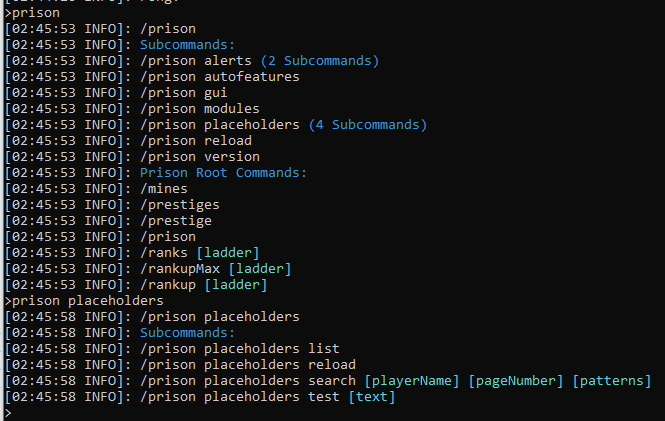
Example of placeholder command listings
Prison Placeholder Listings
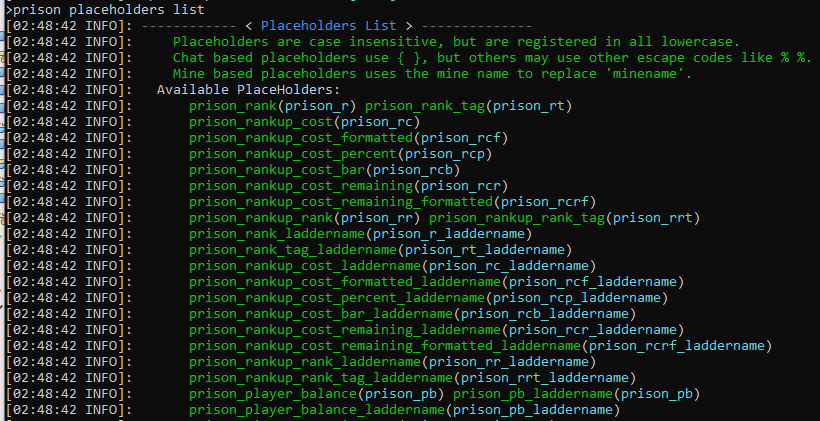
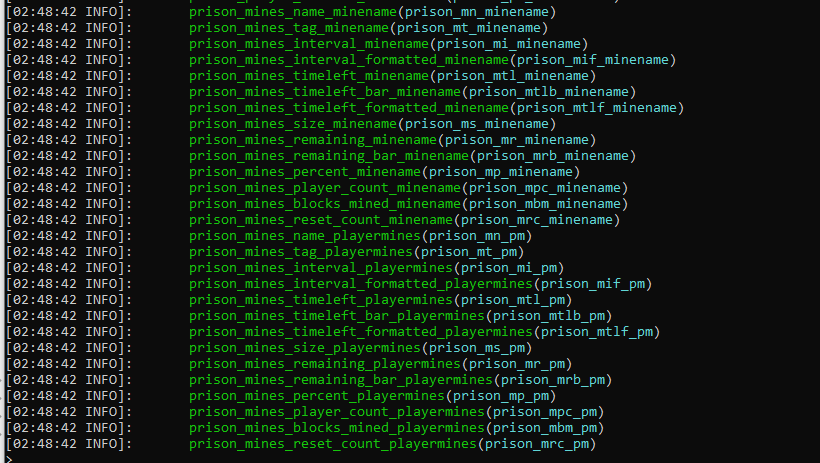
Example of the list of placeholders that is available through /prison placeholders list. Please note that this list may evolve as new placeholders are added. Use these commands to get the current listing that is available on your server.
Prison Placeholder Search with Two Search Patterns
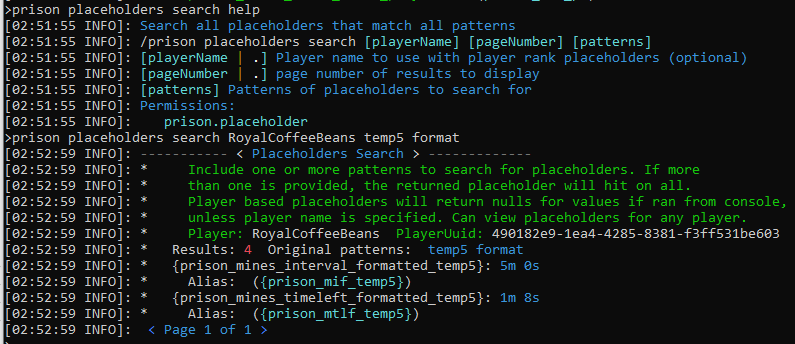
This is an example of searching for placeholders using a player’s name plus two search patterns: temp5 and format. The term temp5 is the name of a mine and is an example of a the dynamic construction of placeholders, and that you can still perform a search with them. The search patterns can be any String fragment found in either the placeholder, or it’s alias.
If more than one search pattern is provided, then all patters must hit on the same placeholder to be included in the results. They behave as a logical AND relationship.
A player’s is provided, but results do not include any player, rank, or ladder entries. This shows that if a player’s name is provide, it is recognized as a player and will not prevent valid hits.
The following example shows what the command is like when specifying the player’s name, a page numer for the results, and three search parameters:
/prison placeholders search RoyalCoffeeBeans 1 rankup cost default
This example shows the current placeholder values for that player, including an example of a bar graph.
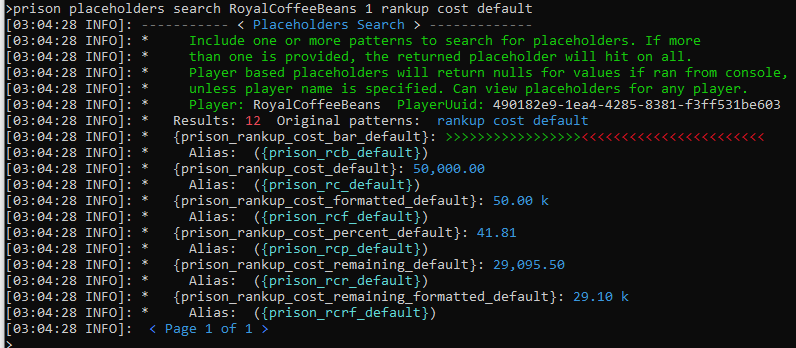
Prison Placeholder Listings - All Placeholders
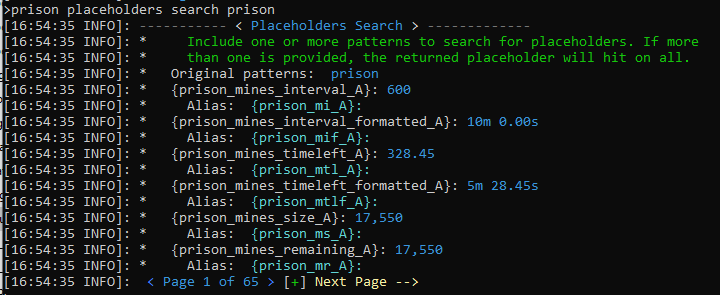
In this contrived example, since all placeholders begin with “prison”, this search returns a listing of all placeholders. In this example, using the current Prison v3.2.1-alpha.13 release, it has generated 65 pages of results, at 6 placeholders per page which includes the alias.
The following shows an example of all placeholders that are active with Prison_v3.2.2-alpha.10.jar. It includes a total of 1,294 placeholders, on 108 pages. This is based upon 4 ladders, 13 ranks, and 41 mines.
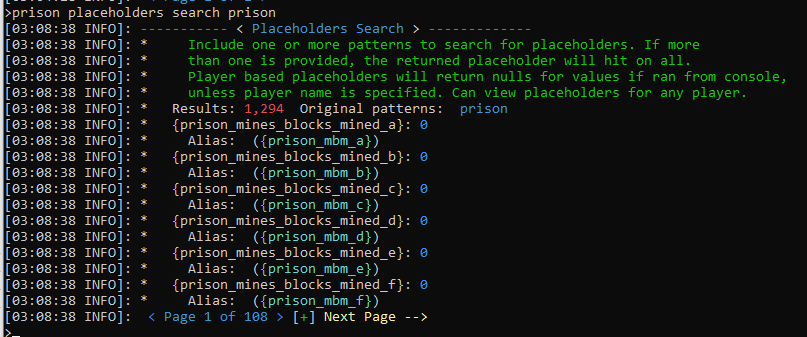
Prison Placeholder Listings

Chat Placeholders
There are two major ways a placeholder can be resolved within Prison: through chat or through a placeholder integration.
Chat based placeholders do not rely on other plugins for them to work. Instead they use the org.bukkit.event.player.AsyncPlayerChatEvent, of which Prison will respond and provide translations to prison related placeholders that it find with the chat message.
Although no plugin is required for Prison to properly handle chat based placeholders, other plugins may be required to generate their use. Such as EssentialsX’s Chat plugin. It provides a way to prefix chat messages with placeholders.
Enabling EssentialX’s Chat Placeholders
Set up the EssentialX’s Chat plugin: Setting up EssentialsX.
Enabling the chat placeholder just requires editing one line within the config.yml file. Search for the keyword EssentialsChat in that file, then edit the format: tag. For example:
format: '<{prison_rank_tag}:{DISPLAYNAME}>{MESSAGE}'
Once setup, restart the server. Or use /essentials reload. Do not force all the plugins to be reloaded with a tool such as plugman since Prison (and other plugins) may fail to re-load properly.
This will include all placeholders that are active for the player, including the prestige chat prefixes. The only issue is that you cannot control the order of how they will display.
It is possible to manually set the order by using the individual placeholders for each rank you want to show. This allows you to omit certain placeholders too. Please see the next section of this document to learn how to set them up.
You can preview all of the placeholders with the placeholder search command.
/prison placeholder search <player> <page> rank_tag
/prison placeholder search RoyalCoffeeBeans rank_tag
/prison placeholder search RoyalCoffeeBeans 2 rank_tag

The placeholders are interested in are: prison_rank_tag_pretiges and prison_rank_tag_default.
So to set them up in the EsstentialsX Chat prefix would be as follows:
format: '<{prison_rank_tag_prestiges}{prison_rank_tag_default}:{DISPLAYNAME}>{MESSAGE}'
Ladder Specific Placeholders
One of the newer features available for placeholders has to do with ladder specific placeholders. This is similar to the mines placeholders but for ladders specifically. These player ladder placeholders are just the same a the player rank, but only for one ladder. The player rank placeholders will return all ranks on all ladders for that placeholder.
This is an example of specifying the rank tag for both the prestige and default ladder. This ensures the expected order of these two tags, but it will also exclude other tags from other ladders, such as donor ladders or mod ladders.
format: '<{prison_rank_tag_prestiges}{prison_rt_default}:{DISPLAYNAME}>{MESSAGE}'
Use the placeholder tools under /prison placeholders for more information and to see what is available for use.
For example, to preview all of the placeholders with the placeholder search command.
/prison placeholder search <player> <page> rank_tag
/prison placeholder search RoyalCoffeeBeans rank_tag
/prison placeholder search RoyalCoffeeBeans 2 rank_tag

Enabling HolographicDisplays Placeholders
Follow directions on how to install and configure the HolographicDisplays plugin.
An important detail to realize, is that HolographicDisplays can only use placeholders that related to the server. It cannot access any of the prison placeholders on its own. It needs the help of other plugins to extend it’s functionality.
The simple directions on how to get everything to work is to download these plugins, and place them all in to your server’s plugin directory. There is no need to modify any config files to get them to work with prison. Prison will register all of the internal placeholders with PlaceholderAPI so it knows they are valid and where to find them (where to send them to be resolved).
The simplest way to create a HolographicDisplay would be to stand where you want one. Then enter the following command:
/hd create test
Then on the server file system, open the file:
plugins\HolographicDisplays\database.yml
Then edit the file. Keep in mind it is a yml file and must be valid yml.
This is an example of a holographic sign:
temp5:
location: world, -99.832, 74.500, 191.215
lines:
- 'Welcome to Prison Mine: temp5'
- 'Reset Interval: {slowest}%prison_mines_interval_temp5% - {slowest}%prison_mines_interval_formatted_temp5%'
- 'Reset Time Left: {medium}%prison_mines_timeleft_temp5% - {fast}%prison_mtlf_temp5%'
- 'Reset Time Left: {slowest}%prison_mines_timeleft_bar_temp5%'
- 'Reset Count: {medium}%prison_mines_reset_count_temp5%'
- 'Mine Size: {slowest}%prison_mines_size_temp5%'
- 'Blocks Remaining: {slowest}%prison_mr_temp5% {slowest}%prison_mp_temp5%%'
- 'Players in Mine: {slowest}%prison_mines_player_count_temp5%'
Notice that the prison placeholders are wrapped in the % % escape characters. The prefixed placeholders such as {slowest} and {fast} are for the plugin HolographicExtensions and they control how frequently the placeholders are refreshed.
This is an example of the above settings, including the bar graph. Notice that the bar graph’s properties can be adjusted for both the characters that are used, and the total number of characters (width). See the configuration within the file /plugins/Prison/config.yml.
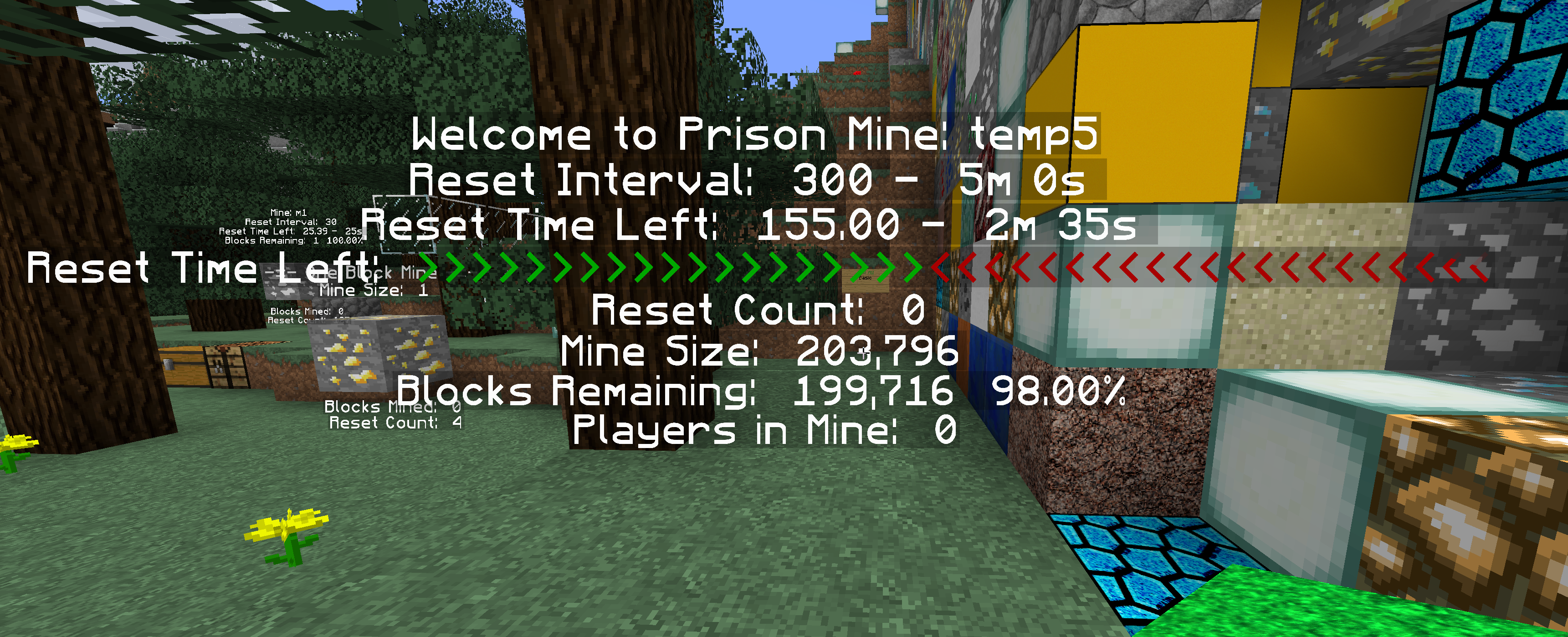
Once you update and save the database.yml file, you can have HolographicDisaplys reload from the files:
/hd reload
The above example will produce a holograph that is too tall and the bottom part will be underground. You can raise it up by manually increasing the Y value stored in location:. As you raise it up, and save the file, then you use /hd reload to refresh. It’s also easier to make changes directly to the database.yml file. Repeat until it looks right.
One word of warning about editing the yml file, is that it must be valid yml, if not, then it could fail to load, or it may reset to a default file. If you’re unsure about the file being proper yml, make sure you save a backup before trying to reload the HolographicDisplays settings. You can also run it through an online yml validator to fix any issues. To find an online yml validator, search for: “online yaml lint” or “online yaml validator”.